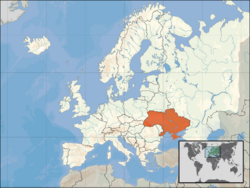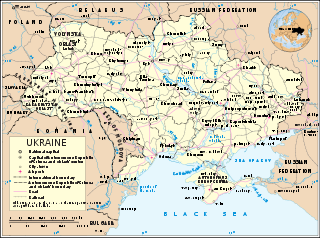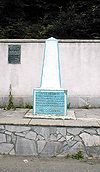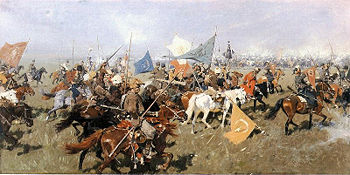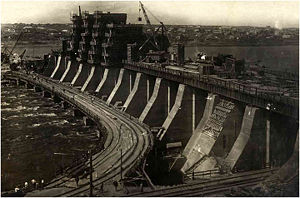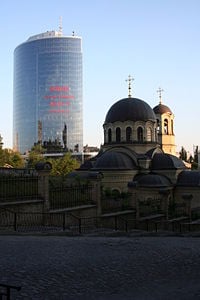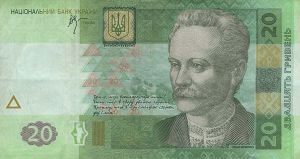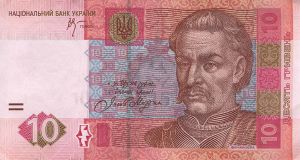Difference between revisions of "Ukraine" - New World Encyclopedia
Mike Butler (talk | contribs) |
Mike Butler (talk | contribs) |
||
| Line 269: | Line 269: | ||
==Economy== | ==Economy== | ||
| − | [[Image:Parus Kyiv.jpg|thumb|left| | + | [[Image:Parus Kyiv.jpg|thumb|left|200px|A new office tower next to a church, Kiev.]] |
[[Image:20-Hryvnia-2003-front.jpg|thumb|20 Hryvnia]] | [[Image:20-Hryvnia-2003-front.jpg|thumb|20 Hryvnia]] | ||
[[Image:10-Hryvnia-2005-front.jpg|thumb|10 Hryvnia]] | [[Image:10-Hryvnia-2005-front.jpg|thumb|10 Hryvnia]] | ||
| − | [[Image:Donezk Schwerindustrie rauchender Schornstein.jpg|thumb|[[Donetsk]] industry]] | + | [[Image:Donezk Schwerindustrie rauchender Schornstein.jpg|thumb|300px|right|[[Donetsk]] industry]] |
| − | [[Image:AN225down.jpg|thumb|Largest airplane in the world [[An-225]]]] | + | [[Image:AN225down.jpg|thumb|400px|right|Largest airplane in the world [[An-225]]]] |
| − | [[Image:Laz 5208.jpg|thumb|Ukrainian | + | [[Image:Laz 5208.jpg|thumb|300px|right|Ukrainian LAZ bus, a winner of "Auto of the year in Ukraine, 2005".]] |
The economy of Ukraine is an emerging free market, that underwent major fluctuations during the 1990s, including [[hyperinflation]] and drastic falls in economic output. As part of the former Soviet Union, the Ukrainian republic was far and away the most important economic component, after Russia, producing about four times the output of the next-ranking republic. Its fertile black soil generated more than one-fourth of Soviet agricultural output, and its farms provided substantial quantities of meat, milk, grain, and vegetables to other republics. Likewise, its diversified heavy industry supplied the unique equipment (for example, large diameter pipes) and raw materials to industrial and mining sites (vertical drilling apparatus) in other regions of the former USSR. | The economy of Ukraine is an emerging free market, that underwent major fluctuations during the 1990s, including [[hyperinflation]] and drastic falls in economic output. As part of the former Soviet Union, the Ukrainian republic was far and away the most important economic component, after Russia, producing about four times the output of the next-ranking republic. Its fertile black soil generated more than one-fourth of Soviet agricultural output, and its farms provided substantial quantities of meat, milk, grain, and vegetables to other republics. Likewise, its diversified heavy industry supplied the unique equipment (for example, large diameter pipes) and raw materials to industrial and mining sites (vertical drilling apparatus) in other regions of the former USSR. | ||
Revision as of 22:08, 19 July 2007
| Україна Ukrayina Ukraine | |||||
| |||||
| Anthem: Ще не вмерла України ні слава, ні воля (Ukrainian) Shche ne vmerla Ukrayiny ni slava, ni volya (transliteration) Ukraine's glory has not yet perished, nor her freedom | |||||
| Capital | Kiev (Kyiv) 50°27′N 30°30′E | ||||
|---|---|---|---|---|---|
| Largest city | capital | ||||
| Official languages | Ukrainian | ||||
| Government | Semi-presidential system | ||||
| - President | Viktor Yushchenko | ||||
| - Prime Minister | Viktor Yanukovych | ||||
| Independence | from the Soviet Union | ||||
| - Declared | August 24 1991 | ||||
| - Referendum | December 1 1991 | ||||
| - Finalized | December 25 1991 | ||||
| Area | |||||
| - Total | 603,700 km² (44th) 233,090 sq mi | ||||
| - Water (%) | 7% | ||||
| Population | |||||
| - 2007 estimate | 46,299,874 | ||||
| - 2001 census | 48,457,102 | ||||
| - Density | 77/km² 199/sq mi | ||||
| GDP (PPP) | 2006 estimate | ||||
| - Total | $355.8 billion | ||||
| - Per capita | $8,000 | ||||
| GDP (nominal) | 2006 estimate | ||||
| - Total | $81.53 billion | ||||
| - Per capita | $1,760 | ||||
| HDI (2004) | |||||
| Currency | Hryvnia (UAH)
| ||||
| Time zone | EET (UTC+2) | ||||
| - Summer (DST) | EEST (UTC+3) | ||||
| Internet TLD | .ua | ||||
| Calling code | +380 | ||||
Ukraine is a country in Eastern Europe, formerly a part of the Soviet Union, bordering Russia, Romania and the Black Sea.
From at least the ninth century, the territory of present-day Ukraine was a centre of medieval East Slavic civilization forming the state of Kievan Rus. After a brief period of independence (1917–1921) following the Russian Revolution of 1917, Ukraine became one of the founding Republics of the Soviet Unions in 1922, and became independent again after the Soviet Union's collapse in 1991.
Ukraine has had a population decline from 51 million in 1989 that was probably caused by economic and environmental crises, including the Chernobyl disaster.
Geography
Theories on the origin of the name differ. The traditional theory is that the Ukrainian word Ukrayina stems from the Old Slavic root kraj-, meaning "edge" or "borderland". In Ukrainian, krayina means "country". In English, the country is sometimes referred to with the definite article, as the Ukraine, similar to the Netherlands, or the Congo. However, usage without the article is now more frequent, and has become established in diplomacy and journalism since the country's independence.
It has a strategic position in Eastern Europe, bordering the Black Sea and Sea of Azov in the south, Poland, Slovakia and Hungary in the west, Belarus in the north, Moldova and Romania in the south-west and Russia in the east.
With an area of 233,074 square miles (603,700 square kilometres), Ukraine is the world's 44th-largest country (after the Central African Republic is the second largest country in Europe (after the European part of Russia), and slightly smaller than Texas.
There is ongoing debate on where the geographical centre of Europe is. Some claim the center is near the small town of Rakhiv, in western Ukraine.
The Ukrainian landscape consists of the Polissya and Volyn northern forests, the central forest steppes, the Donetsk eastern uplands, which are up to 1600 feet (500 meters) above sea level, and the coastal lowlands and steppes along the Black and Azov seas. The Carpathian Mountains in the west reach 6760 feet (2061 meters) at Mount Hoverla. Roman-Kosh in the Crimean peninsula reaches 5061 feet (1543 meters.) Alpine meadows are another interesting feature.
Ukraine has a mostly temperate continental climate, though a more Mediterranean climate is found on the southern Crimean coast. The average temperature in January (winter) is 26°F (-3°C) in the southwest and 18°F (-8°C) in the northeast. The average in July (summer) is 73°F (23°C) in the southeast and 64°F (18°C) in the northwest.
Precipitation is highest in the west and north and lesser in the east and southeast. Winters vary from cool along the Black Sea to cold farther inland. Summers are warm across the greater part of the country, but generally hot in the south.
The main rivers flow northwest to southeast through to empty into the Black Sea and Sea of Azov. The Dnieper River is the longest, with hydroelectric dams, reservoirs, and numerous tributaries, dominates central Ukraine. The Southern Buh with its tributary, the Inhul, flows into the Black Sea. To the west and southwest is the Dniester. The middle course of the Donets]], a tributary of the Don, flows through the south- east. To the southwest the delta of the Danube forms the border with Romania.
Three zones of vegetation appear from north to south: the Polissya (woodland and marsh), the forest-steppe, and the Steppe. The Polissya zone has oak, elm, birch, hornbeam, ash, maple, pine, linden, alder, poplar, willow, and beech. In mountainous areas, the lower slopes are covered with mixed forests, the intermediate slopes have pine forests, with Alpine meadows at higher altitudes.
Ukraine’s fauna is diverse. Predators include the wolf, fox, wildcat, and marten, and hoofed animals include the roe deer, wild pig, elk and mouflon (a wild sheep). Rodents includes gophers, hamsters, jerboas, and field mice. Birds include black and hazel grouse, owl, gull, and partridge, as well as wild goose, duck, and stork. Fish include pike, carp, bream, perch, sturgeon, and sterlet.
Natural resources comprise iron ore, coal, manganese, natural gas, oil, salt, sulfur, graphite, titanium, magnesium, kaolin, nickel, mercury, timber, and arable land.
The country has significant environmental problems, especially those resulting from the Chernobyl nuclear power plant disaster in 1986, and subsequent radiation contamination in the northeast. Other issues include inadequate supplies of potable water, air and water pollution, and deforestation. Conservation of natural resources is a stated high priority, although implementation suffers from a lack of financial resources.
The historic city of Kiev is the capital and the largest city of Ukraine, located in the north central part of the country on the Dnieper river. In 2005 Kiev had 2,660,401 inhabitants, and this figure continues to grow. Kiev is an important industrial, scientific, educational and cultural center of Eastern Europe. It is home to many high-tech industries, higher education institutions and world-famous historical landmarks. The city has an extensive infrastructure and highly developed system of public transport, including the Kiev Metro.
History
The first identifiable groups to populate what is now Ukraine were the Chalcolithic people of the Trypillian culture in the western part, and the Sredny Stog culture further east, succeeded by the early Bronze Age Yamna culture of the steppes, which left hundreds of crude stone stela, and by the Catacomb culture in the third millennium B.C.E.
During the Iron Age, these were followed by the Cimmerians, Scythians, Sarmatians, among other pastoral nomads, along with ancient Greek colonies founded from the sixth century B.C.E. on the north-eastern shore of the Black Sea, the colonies of Tyras, Olbia, Hermonassa, perpetuated by Roman and Byzantine cities until the sixth century C.E.
In the third century C.E., the Goths arrived in the lands of Ukraine, which they called Oium, corresponding to the archaeological Chernyakhov culture. The Ostrogoths stayed in the area but came under the sway of the Huns from the 370s. North of the Ostrogothic kingdom was the Kiev culture, flourishing from the second to fifth centuries, when the Huns overran it. After they helped defeat the Huns at the battle of Nedao in 454, the Ostrogoths were allowed to settle in Pannonia.
With the power vacuum created with the end of Hunnic and Gothic rule, Slavic tribes, possibly emerging from the remnants of the Kiev culture, began to expand over much of what is now Ukraine during the fifth century, and beyond to the Balkans from the sixth century.
In the seventh century, the territory of modern Ukraine was the core of the state of the Bulgars (often referred to as Old Great Bulgaria) who had their capital in the city of Phanagoria.
The majority of the Bulgar tribes migrated in several directions at the end of the seventh century and the remains of their state was swept by the Khazars, a semi-nomadic people from Central Asia. The Khazars founded the independent Khazar kingdom in the south-eastern part of today's Europe, near the Caspian Sea and the Caucasus. In addition to western Kazakhstan, the Khazar kingdom also included territory in what is now eastern Ukraine, Azerbaijan, southern Russia, and Crimea.
Golden Age of Kiev
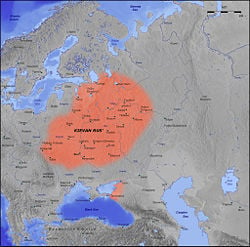
Rus is mentioned for the first time by European chroniclers in 839 C.E. Kievan Rus' was comprised from several principalities, ruled by the interrelated Rurikid princes. The Kievan state experienced a cultural and commercial flourishing from the ninth to the eleventh centuries under the rulers Volodymyr I (980-1015), his son Yaroslav I the Wise (1019-1054), and Volodymyr Monomakh (1113-1125). Volodymyr I Christianized Rus in 988 C.E., while the other two gave it a legal code. Christianity brought the alphabet, developed by the Macedonian saints Cyril and Methodius.
This state laid the foundation for the national identity of Ukrainians, as well as other East Slavic nations. Its capital was Kiev, wrestled from Khazars by Askold and Dir in about 860. The Kievan Rus' elite initially consisted of Varangians from Scandinavia who later became assimilated into the local Slavic population and gave the Rus' its first powerful dynasty, the Rurik Dynasty.
With the death of Mstislav of Kiev (1125–1132) the Kievan Rus' finally disintegrated into the separate principalities. The thirteenth century Mongol invasion dealt Rus' a final blow from which it never recovered.
Mongols, Lithuanians and Poles
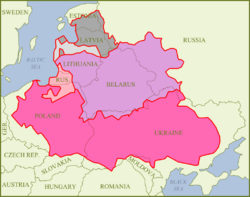
Kievan Rus' was succeeded by the principalities of Halych and Volhynia, which were merged into the state of Halych-Volynia, which resisted the Mongols and Tatars and became a Rus bastion through the fourteenth century. A distinguished ruler was Danylo Romanovich, the only Ukrainian king crowned by the Pope Innocent IV in 1264.
After the fourteenth century, Rus fell under foreign domination. Lithuania controlled most of the Ukraine lands except for Halych and Volhynia, defeated by Poland. The Golden Horde, an outpost of Genghis Khan's empire controlled the southern steppes and the Black Sea coast. The Crimean khanate, an Ottomans vassal state, succeeded the Golden Horde from 1475.
Eventually, the Grand Duchy of Lithuania controlled north-west and central Ukraine. The Grand Duchy adopted the Rus administration and the legal system, while the state language that was Old Slavonic, including a great deal of vernacular Ukrainian and Belorussian. But from 1386, after a dynastic link with Poland, Lithuania adopted Roman Catholicism and Polish language and customs. The common people, especially the peasants, retained their allegiance to their historic Eastern Orthodox Church, which led to the increasing social tensions
By the 1569 Union of Lublin that formed the Polish-Lithuanian Commonwealth, a significant part of Ukrainian territory was moved from largely Ruthenized Lithuanian rule to the Polish administration, as it was transferred to the Polish Crown. The 1596 Brest-Litovsk Union divided Ukrainians into Orthodox and Uniate Catholics. Sigismund III Vasa, who attempted to bring the Orthodox population under the Catholicism through creation of the Ukrainian Greek Catholic Church. While the upper class increasingly turned to Catholicism, the Ukrainian commoners, deprived of their native protectors among Ruthenian nobility, turned for protection to the Cossacks who remained fiercely Orthodox at all times.
From 1569 the Polish-Lithuanian Commonwealth suffered a series of Tatar invasions. The borderland area to the south-east was in a state of semi-permanent warfare until the eighteenth century. More than three million people, predominantly Ukrainians but also Circassians, Russians, Belarusians and Poles, were captured and enslaved during the time of the Crimean Khanate.
The Cossacks
In the mid of the seventeenth century, a Cossack state, the Zaporozhian Sich, was established by the Dnieper cossacks and the Ruthenian peasants fleeing Polish serfdom. Zaporozhian Cossacks, who were based on an island fortress below the Dnipro River rapids, became symbols of Ukrainian national identity.
Strife between Ukrainians and their Polish overlords, over exploitation of peasants and suppression of the Orthodox church, began in the 1590s, spearheaded by the Cossacks. In 1648, Bohdan Khmelnytsky led the largest of the Cossack uprisings] against the Commonwealth and the Polish king John II Casimir. This uprising finally led to a partition of Ukraine between Poland and Russia. Khmelnytsky sought help against the Poles in a treaty with Moscow in 1654. The Muscovites used as a pretext for occupation. Left-Bank Ukraine was eventually integrated into Russia as the Cossack Hetmanate.
The hetmanate reached its pinnacle under Ivan Mazepa (1687–1709). Literature, art, architecture (in Cossack baroque style), and learning flourished. Mazepa sought a united Ukrainian state, under the tsar's sovereignty. When Tsar Peter threatened Ukrainian autonomy, Mazepa allied with Charles XII of Sweden and rose against him, to be defeated in the Battle of Poltava in 1709.
Russian domination
By the end of the eighteenth century, Western Ukrainian (Galicia]]) was taken over by Austria, while the rest of Ukraine was progressively incorporated into the Russian Empire. Empress Catherine II extended serfdom to the traditionally free Cossack regions and destroyed the Zaporozhian Sich in 1775. Russia repressed any movement towards national identity during the nineteenth century. The Ukrainian language was banned from all but domestic use.
However, many Ukrainians accepted their fate in the Russian Empire and some were to achieve a great success there. Many Russian writers, composers, painters and architects of the nineteenth century were of Ukrainian descent. Probably, the most notable was Nikolai Gogol, one of the greatest writers in the Russian literature.
World War I
During World War I Austro-Hungarian authorities subjected Ukrainians in Galicia who sympathized with Russia to repression. Over 20,000 supporters of Russia were arrested and placed in an Austrian concentration camp in Talerhof, Styria, and in a fortress at Terezín (now in the Czech Republic).
When World War I and the October Revolution in Russia shattered the Austrian and Russian empires, Ukrainians were caught in the middle. Between 1917 and 1918, several separate Ukrainian republics manifested independence, the Tsentral'na Rada, the Hetmanate, the Directorate, the Ukrainian People's Republic and the West Ukrainian People's Republic.
In this time, most of the resistance against the Austro-Germans and the Red Army was made by the army of Nestor Makhno, who led an Anarchist revolution in this period, the Makhnovism.
With the defeat in the Polish-Ukrainian War and then the failure of the Józef Piłsudski's and Symon Petlura's Kiev Offensive, by the end of the Polish-Soviet War after the Peace of Riga in March 1921, the western part of Galicia had been incorporated into Poland, and the larger, central and eastern part became part of the Soviet Union as the Ukrainian Soviet Socialist Republic.
Despite the turbulence, this period saw a resurgence of Ukrainian-language publication, which had been controversial in Austro-Hungary, and persecuted in the Russian Empire. The Hetmanate, installed by Germany while overthrowing the government of the UNR conducted state policies directed at bolstering the Ukrainian culture and education. Among the Bolsheviks, national identity was controversial, but the so-called Kiev faction pushed for Ukrainization as well.
Early Soviet years
The Ukrainian national idea lived on during the early-Soviet years and the Ukrainian culture and language enjoyed a revival as the “Ukrainization” became a local implementation of the Soviet-wide "indigenization" policy whose gains were sharply reversed by the early-1930s policy changes.
Ukraine saw its share of Soviet industrialization starting from the late 1920s and the republic's industrial output quadrupled in the 1930s. However, the industrialization had a heavy cost for the peasantry, demographically a backbone of the Ukrainian nation. To satisfy the state's need for increased food supplies and finance industrialization, Stalin instituted a program of collectivization of agriculture as the state combined the peasants' lands and animals into collective farms and enforcing the policies by the regular troops and secret police. Those who resisted were arrested and deported and the increased production quotas were placed on the peasantry.
The collectivization had a devastating effect on agricultural productivity. As the members of the collective farms were not allowed to receive any grain until the unachievable quotas were met, the starvation became widespread. Millions starved to death in a famine, known as the Holodomor.Available data is inconclusive as the Soviet government actively denied the existence of the famine. Therefore, precise calculations and estimates vary.
The times also coincided with the Soviet assault on the national political and cultural elite often accused in "nationalist deviations" as the Ukrainization. These policies were reversed at the turn of the decade. Two waves of purges (1929–1934 and 1936–1938) resulted in the elimination of four fifths of the Ukrainian cultural elite.
World War II
During World War II, some elements of the Ukrainian nationalist underground fought both Nazi and Soviet forces, forming the Ukrainian Insurgent Army in 1942, while other Ukrainians initially collaborated with the Nazis, having been ignored by all other powers. In 1941 the German invaders and their Axis allies initially advanced against desperate but unsuccessful efforts of the Red Army. In the encirclement battle of Kiev, the city was acclaimed by the Soviets as a "Hero City", for the fierce resistance of the Red Army and of the local population. More than 650,000 Soviet males between the ages of 15-50 were taken captive.
Initially, many Ukrainians received the Germans as liberators, especially in western Ukraine, that the Soviets occupied in 1939. However, German rule in the occupied territories eventually aided the Soviet cause. Nazi administrators of conquered Soviet territories made little attempt to exploit the population of Ukrainian territories' dissatisfaction with Soviet political and economic policies. Instead, the Nazis preserved the collective-farm system, systematically carried out genocidal policies against Jews, deported others (mainly Ukrainians) to work in Germany, and began a systematic depopulation of Ukraine to prepare it for German colonization, which included a food blockade on Kiev. Under these circumstances, most people living on the occupied territory passively or actively opposed the Nazis.
Total civilian losses during the war and German occupation in Ukraine are estimated between five and eight million, including over half a million Jews killed by the Einsatzgruppen, sometimes with the help of local collaborators. Of the estimated 8.6 million Soviet troops who fell in battle against the Nazis, about a quarter (2.7 million) were ethnic Ukrainians. Ukraine is distinguished as one of the first nations to fight the Axis powers in Carpatho-Ukraine, and one that saw some of the greatest bloodshed during the war.
Resistance
The republic was heavily damaged by the war, and it required significant efforts to recover. The situation was worsened by a man-made famine in 1946–47, when the Soviet authorities forcibly confiscated grain crops, ignoring drought conditions of 1946. Collected grain was distributed to the other regions of Soviet Union, and on the top, 2.5 million tonnes were exported abroad. In Ukraine about one million people, predominantly in rural areas, died from the famine.
In the Western Ukraine, Ukrainians continued to resist Soviet rule, and the Ukrainian Insurgent Army, formed in World War II to fight both Soviets and Nazis, continued to fight the USSR into the 1950s. Using guerrilla war tactics, the insurgents assassinated Soviet party leaders, NKVD and military officers. In particular, due to the resistance, the 1946-47 famine was much less severe in West Ukraine than in other Ukrainian regions.
Following the death of Stalin in 1953, Nikita Khrushchev became the new leader of USSR. Being the First Secretary of Communist Party of Ukrainian SSR in 1938-49, Khrushchev played a role in Stalin's repressions, the liberation of Ukraine from the Nazis, organization of the man-made famine in 1946-47 and suppression of resistance in West Ukraine. But after taking the power, he found it best to propagandize the friendship between the Ukrainian and Russian nations. In 1954, the 300th anniversary of the Treaty of Pereyaslav was widely celebrated, and in particular, the Crimea was transferred from the Russian SFSR to the Ukrainian SSR.
In the times of Khrushchev Thaw of 1960s, there were dissident movements in Ukraine by such prominent figures as Vyacheslav Chornovil, Vasyl Stus, Levko Lukyanenko. As in the other regions of USSR, the movements were quickly suppressed.
In the 1970s, the new Soviet leader, Leonid Brezhnev was gradually concentrating on power. In 1972, the First Secretary of Communist Party of Ukraine Petro Shelest lost his position, as he was seen as being "too independent" by the government in Moscow, and was replaced by Volodymyr Shcherbytsky.
The rule of Shcherbytsky was characterized by the expanded policies of Russification. At the same time he used his influence as the First Secretary of CPU, and a Politburo member for over 25 years, to advocate economic interests of Ukraine within the USSR.
Chernobyl disaster
On April 26, 1986, a nuclear reactor exploded at the Chernobyl nuclear power plant. The disaster was the product of a flawed reactor design coupled with serious mistakes made by the plant operators in the context of a system where training was minimal. Large areas of Belarus, Ukraine, Russia and beyond were contaminated in varying degrees. Around 150,000 people were evacuated from the contaminated area, and 300,000–600,000 took part in the clean-up. By the year 2000, about 4000 cases of thyroid cancer had been diagnosed in exposed children. After the accident a 30km exclusion zone was established around the power plant. A new city, Slavutych, was built outside the exclusion zone to house and support the employees of the plant.
Independence
The wave of [[Soviet Premier Mihail Gorbachev’s “perestroika” economic restructuring came to Ukraine only in 1988–89. It was hindered initially by Shcherbytsky and party heads, and the economic slowdown and product shortages were initially not as severe in Ukraine as in the other regions of USSR.
In 1989, the national movement "People's Movement of Ukraine", known in short as Rukh was formed. In the elections to the parliament of republic, which were held in March of 1990, Rukh obtained overwhelming support in West Ukraine, as well as in the cities of Kiev and Kharkiv.
In January of 1990, hundreds of thousands of Ukrainians organized a human chain for independence in memory of 1919 unification of Ukrainian People's Republic and West Ukrainian National Republic. On July 16, 1990 the new parliament adopted the Declaration of State Sovereignty of Ukraine, establishing the principles of the self-determination, democracy, political, and economic independence, and the priority of Ukrainian law on the Ukrainian territory over Soviet law. A month earlier, a similar declaration was adopted by the parliament of Russian SFSR. It opened a period of confrontation between the central Soviet, and new republican authorities.
In March of 1991, central Soviet authorities organized a referendum, asking people to express the desire to live in "renewed" Soviet Union. The Ukrainian parliament added a second question, asking Ukrainian citizens the desire to live in the Soviet Union on the principles established in the Declaration of State Sovereignty. The citizens of Ukraine responded positively to both questions.
In August of 1991, the conservative Communist leaders of Soviet Union attempted a coup to remove Gorbachev and to restore Communist party power. After the attempt failed, on August 22, 1991, the Ukrainian parliament adopted the Act of Independence of Ukraine in which the parliament declared Ukraine as independent democratic state.
A referendum and the first presidential elections took place on December 1, 1991. That day, more than 90 percent of Ukrainians expressed their support for the Act of Independence, and they elected the chairman of the parliament, Leonid Kravchuk to serve as the first president.
At the Belavezha Accords on December 8, followed by the Alma Ata meeting on December 21, the leaders of Belarus, Russia, and Ukraine, formally dissolved the Soviet Union, and formed the Commonwealth of Independent States.
Recession
Private property rights were reinstated from 1991, collective farms were abolished in 2000, and peasants received land titles. Initially viewed as having more favorable economic conditions than other regions of the Soviet Union, Ukraine soon went into a deep economic slowdown, losing 60 percent of its Gross domestic product from 1991-1999, and sustaining five-digit inflation rates. Dissatisfied with the economic conditions, as well as crime and corruption, Ukrainians protested and went on strikes. In 1994, the President Kravchuk lost an early presidential election to former Prime-Minister Leonid Kuchma.
Under Kuchma, who served two terms as the President, the Ukrainian economy stabilized by the end of 1990s, and ever since 2000 it enjoyed a steady economic growth averaging approximately seven percent annually. A new constitution was adopted in 1996, which turned Ukraine into a semi-presidential republic, and established a stable political system. Kuchma was, however, criticized by opponents for concentrating too much of power in his office, corruption, transferring public property into hands of loyal oligarchs, discouraging free speech, and election fraud.
The first National Space Agency of Ukraine astronaut to enter space under the Ukrainian flag was Leonid Kadenyuk on May 13, 1997. Ukraine became an active participant in scientific space exploration and remote sensing missions. In a period from 1992 to 2007 Ukraine has launched six Ukrainian-built satellites, and 97 launch vehicles.
Orange revolution
In 2004, Victor Yanukovich, then Prime Minister, was declared the winner of the presidential elections, which had allegedly been rigged. Victor Yuschenko challenged the results and led the peaceful Orange Revolution, which brought him and Yulia Tymoshenko to power, while casting Viktor Yanukovych in opposition.
The 2006 parliamentary election resulted in a government formed by the "Anti-Crisis Coalition" including the Party of Regions, Communist Party, and Socialist Party of Ukraine. The latter party switched from the "Orange Coalition" with Our Ukraine, and the Yulia Tymoshenko Bloc. The new coalition nominated Viktor Yanukovych for the post of Prime Minister. Yanukovich once again became the Prime Minister, while the leader of Socialist Party, Oleksander Moroz, managed to secure the chairman of parliament position.
Government and politics
Ukraine is a republic under a semi-presidential system with separate legislative, executive, and judicial branches. Ukraine in 2006 underwent an extensive constitutional reform that has changed the balance of power between the executive and legislative branches and their relationship to the president. A reform to local self-government has been suggested, but is yet to be formally approved.
According to the constitution the president is the head of state, and is elected by popular vote for a five-year term. The last presidential elections were held in 2004. Viktor Yushchenko has been president since January 23, 2005. Although the constitutional reform substantially reduced presidential authority, the president continued to wield significant power, partially due to a strong tradition of central authority in the country.
The Verkhovna Rada, a unicameral parliament of 450 seats amends the Constitution of Ukraine, drafts laws, ratifies international treaties, appoints a number of officials, and elects judges. Members are allocated on a proportional basis to those parties that gain three percent or more of the national electoral vote, to serve five-year terms. Elections were last held on March 26, 2006. Ukraine has a large number of political parties, many of which have tiny memberships and are unknown to the general public. Small parties often join in multi-party coalitions (electoral blocks) for the purpose of participating in parliamentary elections. Suffrage is universal to those aged 18 years and over.
The Verkhovna Rada is primarily responsible for the formation of the executive branch, the Cabinet of Ministers, which is headed by the prime minister, who is head of government. Viktor Yanukovych has been prime minister since August 4, 2006. The prime minister selects the cabinet of ministers. Constitutional reform has increased the authority of the Verkhovna Rada over the selection and oversight of the executive branch.
The judiciary comprises a constitutional court, a supreme court, a high arbitration court , a high administrative court, regional, military, and specialized courts of appeal, local district courts, and military garrison courts. The constitution provides for trials by jury, although by 2007, this had not been implemented. The legal system is based on civil law system.
Local self-government is officially guaranteed. Local councils and city mayors are popularly elected and exercise control over local budgets. The president appoints the heads of regional and district administrations.
Reform fall-out
A substantial constitutional reform introduced in the beginning of 2006 were meant to transform the Ukrainian state from a presidential republic to a mixed parliamentary-presidential republic. However, the amendments created an environment for conflict between the president and the parliamentary coalition. The political life of Ukraine during the 2006-07 year was a constant power struggle between the president and the prime minister, aggravated by the fact that the president and the prime minister represent the opposite parts of the political spectrum and differ on foreign and the internal policy. The president Viktor Yushchenko accuses the coalition of trying to usurp the powers he preserved in the reform, while the coalition alleges the president is unwilling to accept the consequences of the reform and is trying to regain his former powers.
Crowds of about 70,000 gathered on Maidan Nezalezhnosti, the central square of Kiev, and supported the dismissal of parliament, with 20,000 supporting Yanukovych's plan to keep the parliament together. On April 3, 2007, President Yushchenko dissolved the Ukrainian parliament and ordered an early election to be held May 27, 2007. The Verkhovna Rada called an emergency session and voted against Yuschenko's decree (255 votes in favor; opposition didn't participate). A group of members of the parliament took the case to the Constitutional Court of Ukraine, challenging the validity of the president's decree, but the court closed the case without opinion. A political struggle ensued between the parliamentary coalition and the opposition. Yushchenko and Yanukovych agreed to reschedule parliamentary elections for September 30, 2007.
Ukraine is subdivided into 24 oblasts (provinces) and one autonomous republic (avtonomna respublika), Crimea. Additionally, two cities (misto), Kiev and Sevastopol, have a special legal status. The oblasts are subdivided into 494 raions (districts).
International relations
Ukraine considers Euro-Atlantic integration its primary foreign policy objective, but in practice balances its relationship with Europe and the United States with strong ties to Russia. The European Union's Partnership and Cooperation Agreement (PCA) with Ukraine went into force in 1998. The EU Common Strategy toward Ukraine, issued in 1999, recognizes Ukraine's long-term aspirations but does not discuss association. In 1992, Ukraine joined the Organization for Security and Cooperation in Europe—OSCE), and the North Atlantic Cooperation Council. Ukraine also has a close relationship with NATO and has declared interest in eventual membership. It is the most active member of the Partnership for Peace (PfP). President Viktor Yushchenko said he want that Ukraine should join the EU in future.
Ukraine has especially close ties with Russia and Poland. Relations with Russia are complicated by energy dependence and by payment arrears. However, relations have improved with the 1998 ratification of the bilateral Treaty of Friendship and Cooperation. Also, the two sides have signed a series of agreements on the final division and disposition of the former Soviet Black Sea Fleet that have helped to reduce tensions. Ukraine became a member of the Commonwealth of Independent States (CIS) in 1991, but in 1993 it refused to endorse a draft charter strengthening political, economic, and defense ties among CIS members. Ukraine was a founding member of GUAM (Georgia-Ukraine-Azerbaijan-Moldova).
In 1999-2001, Ukraine served as a non-permanent member of the UN Security Council. Soviet Ukraine joined the United Nations in 1945 as one of the original members following a Western compromise with the Soviet Union, which had asked for seats for all 15 of its union republics. Ukraine has consistently supported peaceful, negotiated settlements to disputes. Ukraine also has made a substantial contribution to UN peacekeeping operations since 1992.
Military
After the collapse of Soviet Union, Ukraine inherited a one-million-man military force on its territory, equipped with the third largest nuclear weapon arsenal in the world. In May of 1992, Ukraine signed the Strategic Arms Reduction Treaty (START) in which the country agreed to give up all nuclear weapons, and to join the Nuclear Non-Proliferation Treaty as a non-nuclear weapon state. Ukraine ratified the treaty in 1994, and by 1996 the country became free of nuclear weapons.
Ukraine also reduced conventional weapons. It signed the Treaty on Conventional Armed Forces in Europe, and reduced the army to 300,000 soldiers. The country plans to convert the mostly conscript, army into a professional army.
Following independence, Ukraine declared itself to be a neutral state. The country had a limited military partnership with Russia and other CIS countries, as well as, since 1994, it established a partnership with NATO. In 2000s Ukraine was leaning toward NATO, and a NATO-Ukraine Action Plan signed in 2002 led to deeper cooperation. In August of 2006, the leading political parties agreed that the question of joining NATO should be answered by a national referendum.
Economy
The economy of Ukraine is an emerging free market, that underwent major fluctuations during the 1990s, including hyperinflation and drastic falls in economic output. As part of the former Soviet Union, the Ukrainian republic was far and away the most important economic component, after Russia, producing about four times the output of the next-ranking republic. Its fertile black soil generated more than one-fourth of Soviet agricultural output, and its farms provided substantial quantities of meat, milk, grain, and vegetables to other republics. Likewise, its diversified heavy industry supplied the unique equipment (for example, large diameter pipes) and raw materials to industrial and mining sites (vertical drilling apparatus) in other regions of the former USSR.
Shortly after independence was ratified in December 1991, the Ukrainian Government liberalized most prices and erected a legal framework for privatization, but widespread resistance to reform within the government and the legislature soon stalled reform efforts and led to some backtracking. Output by 1999 had fallen to less than 40 percent of the 1991 level. Loose monetary policies pushed inflation to hyperinflationary levels in late 1993. The prices stabilized only after the introduction of new currency, hryvnia in 1996.
Ukraine's dependence on Russia for energy supplies, and the lack of significant structural reform, has made the Ukrainian economy vulnerable to external shocks. Ukraine depends on imports to meet about three-fourths of its annual oil and natural gas requirements. A dispute with Russia over pricing in late 2005 and early 2006 led to a temporary gas cut-off; Ukraine concluded a deal with Russia in January 2006 that almost doubled the price Ukraine pays for Russian gas, and could cost the Ukrainian economy $1.4-2.2 billion.
Ukrainian Government officials eliminated most tax and customs privileges in a March 2005 budget law, bringing more economic activity out of Ukraine's large shadow economy, but more improvements are needed, including fighting corruption, developing capital markets, and improving the legislative framework for businesses. Reforms in the more politically sensitive areas of structural reform and land privatization are still lagging. Outside institutions - particularly the IMF - have encouraged Ukraine to quicken the pace and scope of reforms. In its efforts to accede to the World Trade Organization (WTO), Ukraine passed more than 20 laws in 2006 to bring its trading regime into consistency with WTO standards.
GDP growth was seven percent in 2006, up from 2.4 percent in 2005 thanks to rising steel prices worldwide and growing consumption domestically. Although the economy is likely to expand in 2007, long-term growth could be threatened by the government's plans to reinstate tax, trade, and customs privileges and to maintain restrictive grain export quotas.
The World Bank classifies Ukraine as a lower middle-income state. For 2006, the Index of Economic Freedom of Ukraine was 3.24, a rank 99 amongst 157 states. Some significant issues are underdeveloped infrastructure and transportation, corruption and bureaucracy, and a lack of modern-minded professionals - despite the large number of universities. But the rapidly growing Ukrainian economy has a very interesting emerging market with a relatively big population, and large profits associated with the high risks.
The Ukrainian stock market grew up 10 times between 2000 and 2006, including the tremendous 341 percent growth in 2004. Growing sectors of the Ukrainian economy include the IT Outsourcing market, which has been growing at over 100 percent per annum.
Exports totalled $38.88-billion in 2006. Export commodities included ferrous and non-ferrous metals, fuel and petroleum products, chemicals, machinery and transport equipment, and food products. Export partners included Russia 22.1 percent, Turkey percent, and Italy 5.6 percent. Imports totalled $44.11-billion. Import commodities included energy, machinery and equipment, and chemicals. Import partners included Russia 35.5 percent, Germany 9.4 percent, Turkmenistan 7.4 percent, and China 5 percent.
Per capita GDP (purchasing power parity) was $8000 in 2006, or ranked 86th on the IMF list of 179 nations. Officially registered unemployment was 2.7 percent, although there was a large number of unregistered or under-employed workers. The International Labor Organization calculated that Ukraine's real unemployment level is 6.7 percent in 2006. Twenty nine percent of the population was below the poverty line in 2003.
Demographics

According to the Ukrainian Census of 2001, ethnic Ukrainians make up 77.8% of the population. Other significant ethnic groups are Russians (17.3%), Belarusians (0.6%), Moldovans (0.5%), Crimean Tatars (0.5%), Bulgarians (0.4%), Hungarians (0.3%), Romanians (0.3%), Poles (0.3%), Jews (0.2%), Armenians (0.2%), Greeks (0.2%) and Tatars (0.2%).[1]
The industrial regions in the east and south-east are the most heavily populated, and about 67.2% of the population lives in urban areas.
Ukrainian is the only official state language. Russian, which was a de facto official language in the Soviet Union, is widely spoken, especially in eastern and southern Ukraine. According to the census, 67.5% of the population declared Ukrainian as their native language and 29.6% declared Russian.
It is sometimes difficult to determine the extent of the two languages, since many people use a Surzhyk (a mixture of Ukrainian and Russian where the vocabulary is often combined with Ukrainian grammar and pronunciation) while claiming in surveys that they speak Russian or Ukrainian (most of them are able to speak both literary languages though). Besides, some ethnic Ukrainians, while calling Ukrainian their 'native' language, use Russian more frequently in their daily lives.
These details result in a significant difference across different survey results, as even a small restating of a question switches responses of a significant group of people.[2] Standard literary Ukrainian is mainly spoken in western and central Ukraine. In western Ukraine, Ukrainian is also the dominant language in cities (such as Lviv). In central Ukraine, Ukrainian and Russian are both equally used in cities, with Russian being more common in Kiev,[3][2] while Ukrainian is the dominant language in rural communities. In eastern and southern Ukraine, mainly Russian is used in cities, and Surzhyk is used in rural areas.
The government follows a policy of Ukrainization—the increase of Ukrainian language, generally at the expense of Russian. This takes the form of use of Ukrainian in various spheres that are under government control, such as schools, government offices, and some media. This is even done in areas which are largely Russian-speaking. However, in non-government areas of life, the language of convenience (usually Russian) is used.[4]
According to the Autonomous Republic of Crimea constitution, Ukrainian is the only state language of the republic.[5] However, the republic's constitution specifically recognizes Russian as the language of the majority of its population and guarantees its usage 'in all spheres of public life'. Similarly, the Crimean Tatar language (the language of a sizeable 12% minority of the republic[6] is guaranteed a special state protection as well as the 'languages of other ethnicities'. Russian speakers constitute an overwhelming majority of the Crimean population (77%), with Ukrainian speakers comprising 10.1%, and Crimean Tatar speakers 11.4%.[7] But in everyday life the majority of Cimean Tatars and Ukrainians in Crimea use Russian.
Romanians and Moldavians are another significant minority in Ukraine, concentrated mainly in Chernivtsi, Odessa, Zakarpattia and Vinnytsia oblasts.
Jews played a very important role in Ukrainian cultural life, especially in the 19th and first half of the 20th century. Nowadays Yiddish, the Ukrainian Jews' traditional language, is only used by a small number of older people.
After independence, a significant change in the language of instruction in educational institutions took place. According to the Razumkov centre, while 49% of high school students in 1991/92 were receiving their education in Ukrainian, and 50% in Russian, 70% of students in 2000/01 attended Ukrainian schools (where Ukrainian is the primary language of instruction) while 29% were studying in Russian schools (both languages are studied in all schools in Ukraine, as part of the curriculum). This trend is opposite to the changes in the 1970s and 1980s, when the number of Russian schools was constantly being increased. The transition toward Ukrainian-language usage is taking a long time, and in some schools that had switched to Ukrainian from Russian, part or most of the instruction is still given in Russian.
In general, most of the population is bilingual, at least to some degree. Most of the Ukrainophone population is also fluent in Russian and many Russian native speakers in Ukraine are fluent in Ukrainian as well. An overwhelming majority has at least a reasonable command in Ukrainian even in primarily Russophone southern and eastern parts of the country.
Significant migration took place in the first years of Ukrainian independence. More than 1 million people moved into Ukraine in 1991-1992, mostly from the other former Soviet republics. In total, between 1991 and 2004, 2.2 million immigrated to Ukraine (among them, 2.0 million came from the other former Soviet Union states), and 2.5 million immigrated from Ukraine (among them, 1.9 million moved to the rest of former Soviet Union republics).[8]
In the context of low salaries and unemployment within Ukraine, labor emigration became a mass phenomenon at the end of the 1990s. Although estimates vary, approximately two to three million Ukrainian citizens are currently working abroad, many illegally, in construction, service, housekeeping, and agriculture industries. Moreover, a significant number of women from Ukraine had been dragged into prostitution and sex slavery in foreign lands, mainly Western Europe and Turkey.[8]
Religion
The dominant religion in Ukraine is Eastern Orthodox Christianity, which is currently split between three Church bodies: Ukrainian Orthodox Church (Moscow Patriarchate), Ukrainian Orthodox Church - Kiev Patriarchate, and Ukrainian Autocephalous Orthodox Church.
A distant second is the Eastern Rite Ukrainian Greek Catholic Church, which practices a similar liturgical and spiritual tradition as Eastern Orthodoxy, but is in communion with the See of Peter and recognizes the primacy of the Pope as head of the Church.
There are 879 Catholic communities, and 499 clergy members serving the some one million Roman Catholics in Ukraine. The group forms some 2.19% of the population and consists mainly of ethnic Poles, living predominantly in the western regions of the country.
Protestant Christians also form some 2.19% of the population. Protestant numbers have grown greatly since Ukranain independence. Evangelical Baptist Union of Ukraine is the largest group, with more than 300,000 members and about 3,000 clergy members. Other groups include Calvinists, Lutherans, Methodists, Seventh-day Adventists and others.
The Jewish community is a tiny fraction of what it was before World War II, but Jews still form some 0.63% of the population. A 2001 census indicated 103,600 Jews, although community leaders claimed that the population could be as large as 300,000. Most Ukrainian Jews are Orthodox,[9] and there is a small Reform population.
There are an estimated 500,000 Muslims in Ukraine, some 320,000 on the Crimean Peninsula. Most Ukrainian Muslims are Crimean Tatars. In addition, some 50,000 foreign-born Muslims live in Kiev.
In addition, twenty-nine Krishna Consciousness communities and forty-seven Buddhist communities were registered in the country (as of January 1, 2006).
Culture
The culture of Ukraine has been formed by influences of its eastern and western neighbors, and the architecture, music and dance of Ukraine all reflect this.
Communist rule had quite a strong effect on the art and writing of Ukraine. During the late 1920s and early 1930s, the Soviets began enforcing the socialist realism art style in Ukraine; this style dictated that all artists and writers glorify the Soviet Regime with their talents. After the Soviet Union collapsed, Ukrainian artists and writers again became free to express themselves as they wanted.
The tradition of the Easter egg had its beginnings in Ukraine: these eggs were drawn on with wax to create pattern; dye was then added to give the eggs their delightful colors -— the dye not affecting the wax-coated parts of the egg. Once the whole egg was dyed, the wax was removed leaving only the colorful pattern. The tradition is thousands of years old, and predates the arrival of Christianity in the country.
Ukrainians also have food culture which dates back to the old time. The Ukrainian diet includes chicken, pork, beef, fish and mushrooms. Ukrainians eat a lot of potatoes, grains, fresh and sour vegetables, different kinds of bread. Popular traditional dishes include varenyky (boiled dumplings with mushrooms, potatoes, sauerkraut, cottage cheese or cherries), borsch (soup made of beets, cabbage and mushrooms or meat) and holubtsy (stuffed cabbage rolls filled with rice, carrots and meat). Ukrainian specialties also include Chicken Kiev and Kiev Cake. Ukrainians drink stewed fruit, juices, milk, sour milk (They make cottage cheese from this), mineral water, tea and coffee, beer, wine and vodka.
International rankings
| Organization | Survey | Ranking |
|---|---|---|
| Heritage Foundation/The Wall Street Journal | Index of Economic Freedom | 99 out of 157 |
| Reporters Without Borders | Worldwide Press Freedom Index | 105 out of 168 |
| Transparency International | Corruption Perceptions Index | 99 out of 163 |
| United Nations Development Programme | Human Development Index | 77 out of 177 |
| World Economic Forum | Global Competitiveness Report | 78 out of 125 |
| A.T. Kearney/Foreign Policy Magazine | Globalization Index 2005 PDF | 39 out of 62 |
See also
Template:Ukrainian topics
ReferencesISBN links support NWE through referral fees
- ↑ Ethnical composition of the population of Ukraine according to the 2001 Census
- ↑ 2.0 2.1 According to the official 2001 census data (by nationality; by language) approximately 75% of Kiev's population responded 'Ukrainian' to the native language (ridna mova) census question, and roughly 25% responded 'Russian'. On the other hand, when the question 'What language do you use in everyday life?' was asked in the 2003 sociological survey, the Kievans' answers were distributed as follows: 'mostly Russian': 52%, 'both Russian and Ukrainian in equal measure': 32%, 'mostly Ukrainian': 14%, 'exclusively Ukrainian': 4.3%.
"What language is spoken in Ukraine?", Welcome to Ukraine, 2003/2. - ↑ "[As of 2006, in Kiev] Ukrainian is used a home by 23% the respondents [to a survey]; while 52% use Russian and 24% switch between both"
"Kiev: the city, its residents, problems of today, wishes for tomorrow.", Zerkalo Nedeli, April 29 – May 12, 2006.. Available online in Russian and in Ukrainian - ↑ Roman Woronowycz, Ruling on pre-eminence of Ukrainian language stirs controversy, The Ukrainian Weekly, February 27, 2000
- ↑ The Constitution of the Autonomous Republic of Crimea
- ↑ National structure of the population of Autonomous Republic of Crimea, 2001 Ukrainian Census.
- ↑ Linguistic composition of population Autonomous Republic of Crimea, 2001 Ukrainian Census.
- ↑ 8.0 8.1 Olena Malynovska, Caught Between East and West, Ukraine Struggles with Its Migration Policy, National Institute for International Security Problems, Kyiv, January 2006.
- ↑ There were 104 Chabad communities as of 2004 according to the Directory of Chabad-Lubavitch Centers in Ukraine
General
- CIA World Factbook - Ukraine
- Country profile: Ukraine, BBC's Country Profile on Ukraine.
- Country Briefings: Ukraine, by The Economist
- Special Report: Ukraine, ongoing coverage by Guardian Unlimited
- Background Note: Ukraine, the U.S. Department of State website
- Ukraine, Portals to the World, Internet resources selected by Library of Congress subject experts
External links
Official
- The President of Ukraine
- Verkhovna Rada: the parliament of Ukraine
- Government Portal of Ukraine— Branches of government
- Ministry of Foreign Affairs of Ukraine
- Constitution of Ukraine
Miscellaneous
- Open Directory Project - Ukraine directory category
- Ukraine cities and regions guide
- Encyclopedia of Ukraine
- Travel guide to Ukraine from Wikitravel
Religion
Credits
New World Encyclopedia writers and editors rewrote and completed the Wikipedia article in accordance with New World Encyclopedia standards. This article abides by terms of the Creative Commons CC-by-sa 3.0 License (CC-by-sa), which may be used and disseminated with proper attribution. Credit is due under the terms of this license that can reference both the New World Encyclopedia contributors and the selfless volunteer contributors of the Wikimedia Foundation. To cite this article click here for a list of acceptable citing formats.The history of earlier contributions by wikipedians is accessible to researchers here:
The history of this article since it was imported to New World Encyclopedia:
Note: Some restrictions may apply to use of individual images which are separately licensed.


